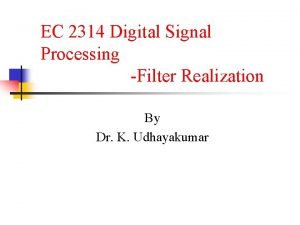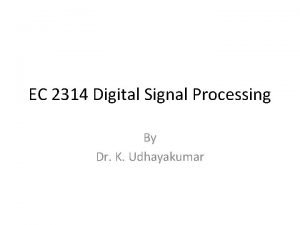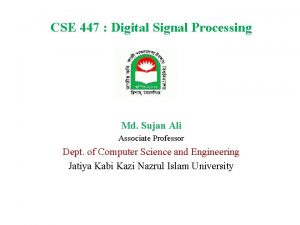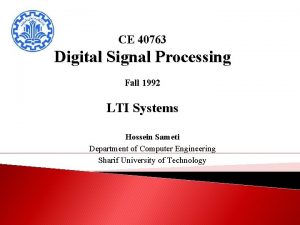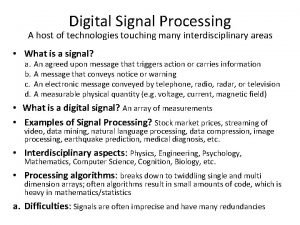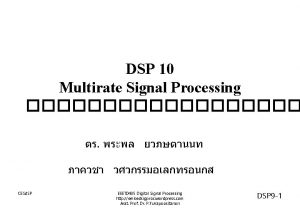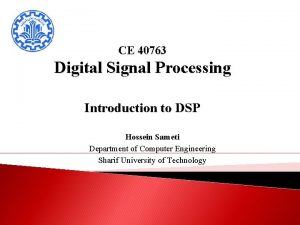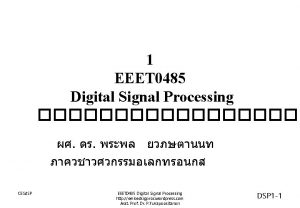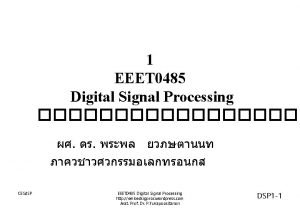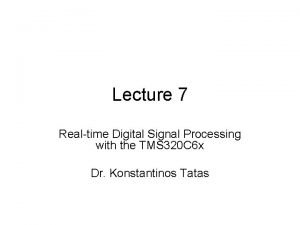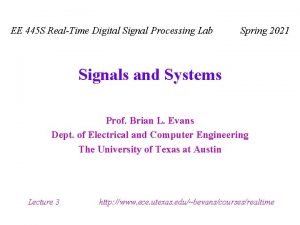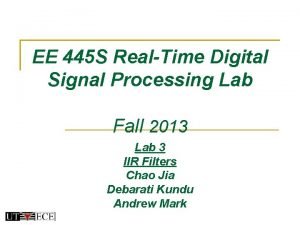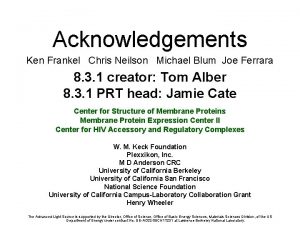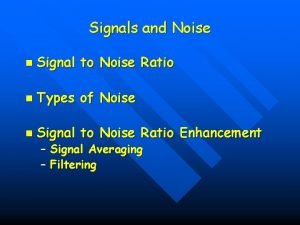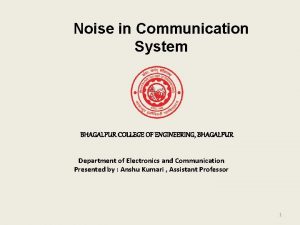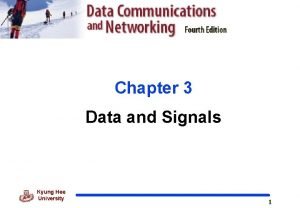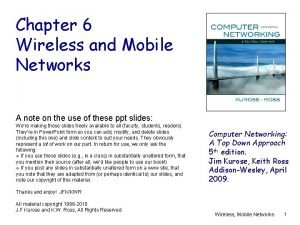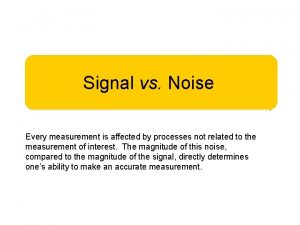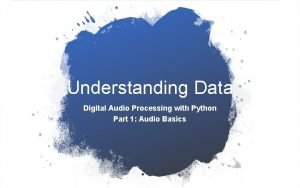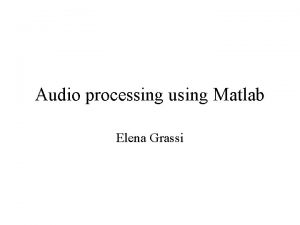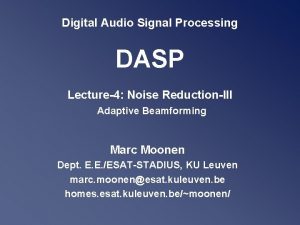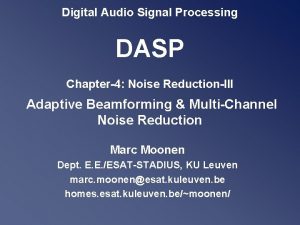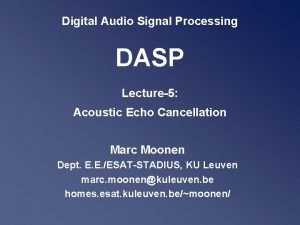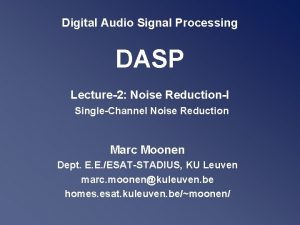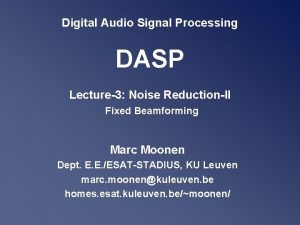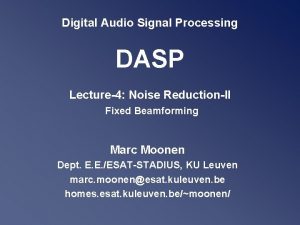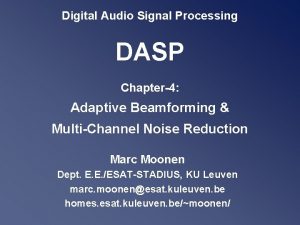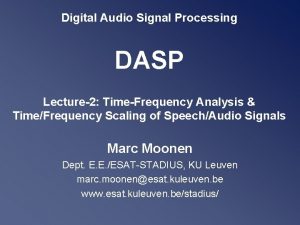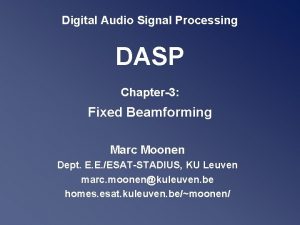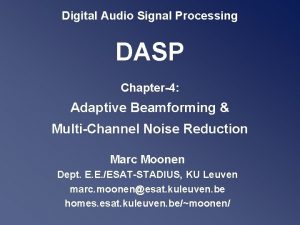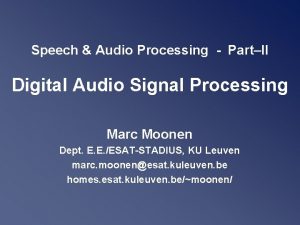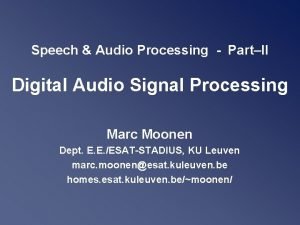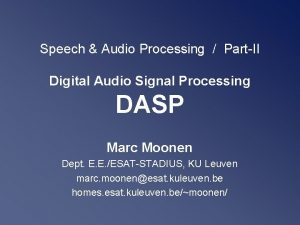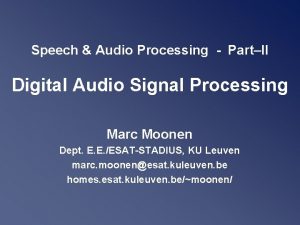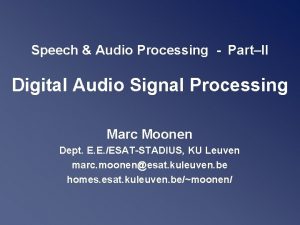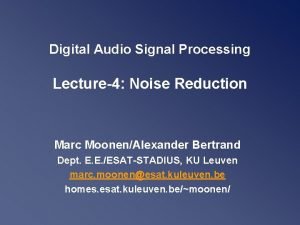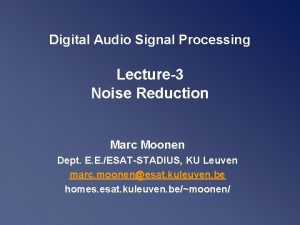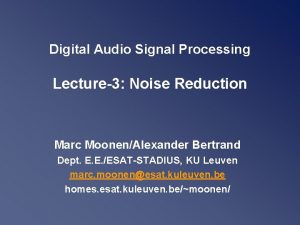Digital Audio Signal Processing DASP Lecture5 Noise ReductionIII


































- Slides: 34

Digital Audio Signal Processing DASP Lecture-5: Noise Reduction-III Adaptive Beamforming Marc Moonen Dept. E. E. /ESAT-STADIUS, KU Leuven marc. moonen@esat. kuleuven. be homes. esat. kuleuven. be/~moonen/

Overview • Beamforming / Recap • Adaptive Beamforming – Adaptive beamforming goal & set-up – LCMV beamformer – Generalized sidelobe canceler • Multi-channel Wiener filter for multimicrophone noise reduction – Multi-microphone noise reduction problem – Multi-channel Wiener filter (=spectral+spatial filtering) Digital Audio Signal Processing Version 2016 -2017 Lecture-5: Adaptive Beamforming 2 / 34

Recap 1/4 Filter-and-sum Beamforming: + : Classification: Fixed beamforming: =Previous lecture data-independent, fixed filters Fm e. g. matched filtering, superdirective, … Adaptive beamforming: =This lecture data-dependent filters Fm e. g. LCMV-beamformer, generalized sidelobe canceler Digital Audio Signal Processing Version 2016 -2017 Lecture-5: Adaptive Beamforming 3 / 34

Recap 2/4 Data model: source signal • Microphone signals are filtered versions of source signal S( ) at angle • Stack all microphone signals (m=1. . M) in a vector d is `steering vector’ Digital Audio Signal Processing Version 2016 -2017 Lecture-5: Adaptive Beamforming 4 / 34

Recap 3/4 Data model: source signal + noise • Microphone signals are corrupted by additive noise Noise correlation matrix is • Output signal after `filter-and-sum’ is Digital Audio Signal Processing Version 2016 -2017 Lecture-5: Adaptive Beamforming 5 / 34

Recap 4/4 Definitions: • Array directivity pattern = `transfer function’ for source at angle • Array Gain = improvement in SNR for source at angle ( -π< < π ) White Noise Gain =array gain for spatially uncorrelated noise Directivity =array gain for diffuse noise Digital Audio Signal Processing Version 2016 -2017 Lecture-5: Adaptive Beamforming 6 / 34

Overview • Beamforming / Recap • Adaptive Beamforming – Adaptive beamforming goal & set-up – LCMV beamformer – Generalized sidelobe canceler • Multi-channel Wiener filter for multimicrophone noise reduction – Multi-microphone noise reduction problem – Multi-channel Wiener filter (=spectral+spatial filtering) Digital Audio Signal Processing Version 2016 -2017 Lecture-5: Adaptive Beamforming 7 / 34

Adaptive beamforming Goal & Set-up • Adaptive filter-and-sum structure: – Aim is to minimize noise output power, while maintaining a chosen response for a given steering angle (and/or other linear constraints, see below). – This is similar to operation of a delay-and-sum beamformer (in white noise) or superdirective beamformer (in diffuse noise), see Lecture 4, (**) p. 22 & 30, but now noise field is unknown & adapted to! + Digital Audio Signal Processing : Version 2016 -2017 Lecture-5: Adaptive Beamforming 8 / 34

Adaptive beamforming Goal & Set-up • Adaptive filter-and-sum structure: – Implemented as adaptive FIR filter : + Digital Audio Signal Processing : Version 2016 -2017 Lecture-5: Adaptive Beamforming 9 / 34

Overview • Beamforming / Recap • Adaptive Beamforming – Adaptive beamforming goal & set-up – LCMV beamformer – Generalized sidelobe canceler • Multi-channel Wiener filter for multimicrophone noise reduction – Multi-microphone noise reduction problem – Multi-channel Wiener filter (=spectral+spatial filtering) Digital Audio Signal Processing Version 2016 -2017 Lecture-5: Adaptive Beamforming 10 / 34

LCMV beamformer LCMV = Linearly Constrained Minimum Variance – f designed to minimize output power (variance) (read on. . ) z[k] : – To avoid desired signal cancellation, add (J) linear constraints Example: fix array response for steering angle ψ & sample freqs ωi For sufficiently large J constrained output power minimization approximately corresponds to constrained output noise power minimization (if source angle is equal to steering angle) (why? ) Digital Audio Signal Processing Version 2016 -2017 Lecture-5: Adaptive Beamforming 11 / 34

LCMV beamformer LCMV = Linearly Constrained Minimum Variance – f designed to minimize output power (variance) (read on. . ) z[k] : – To avoid desired signal cancellation, add (J) linear constraints – Solution is (obtained using Lagrange-multipliers, etc. . ): Digital Audio Signal Processing Version 2016 -2017 Lecture-5: Adaptive Beamforming 12 / 34

Overview • Beamforming / Recap • Adaptive Beamforming – Adaptive beamforming goal & set-up – LCMV beamformer – Generalized sidelobe canceler • Multi-channel Wiener filter for multimicrophone noise reduction – Multi-microphone noise reduction problem – Multi-channel Wiener filter (=spectral+spatial filtering) Digital Audio Signal Processing Version 2016 -2017 Lecture-5: Adaptive Beamforming 13 / 34

Generalized sidelobe canceler (GSC) GSC = Adaptive filter formulation of the LCMV-problem Constrained optimisation is reformulated as a constraint pre-processing, followed by an unconstrained optimisation, as follows: – LCMV-problem is – Define `blocking matrix’ Ca, , columns spanning the null-space of C – Define ‘quiescent response vector’ fq satisfying constraints – Parametrize all f’s that satisfy constraints (verify!) i. e. filter f can be decomposed in a fixed part fq and a variable part Ca. fa Digital Audio Signal Processing Version 2016 -2017 Lecture-5: Adaptive Beamforming 14 / 34

Generalized sidelobe canceler (GSC) GSC = Adaptive filter formulation of the LCMV-problem Constrained optimisation is reformulated as a constraint pre-processing, followed by an unconstrained optimisation, as follows: – LCMV-problem is – Unconstrained optimization of fa : (MN-J coefficients) Digital Audio Signal Processing Version 2016 -2017 Lecture-5: Adaptive Beamforming 15 / 34

Generalized sidelobe canceler GSC (continued) – Hence unconstrained optimization of fa can be implemented as an adaptive filter (adaptive linear combiner), with filter inputs (=‘lefthand sides’) equal to and desired filter output (=‘right-hand side’) equal to – LMS algorithm : Digital Audio Signal Processing Version 2016 -2017 Lecture-5: Adaptive Beamforming 16 / 34

Generalized sidelobe canceler GSC then consists of three parts: • Fixed beamformer (cfr. fq ), satisfying constraints (‘LC’) but not yet minimum variance (‘MV’) ), creating `speech reference’ • Blocking matrix (cfr. Ca), placing spatial nulls in the direction of the speech source (at sampling frequencies) (cfr. C’. Ca=0), creating MN-J `noise references’ • Multi-channel adaptive filter (linear combiner) your favourite one, e. g. LMS Digital Audio Signal Processing Version 2016 -2017 Lecture-5: Adaptive Beamforming 17 / 34

Generalized sidelobe canceler A popular & significantly cheaper GSC realization is as follows y 1 Postproc y. M Note that some reorganization has been done: the blocking matrix now generates (typically) M-1 (instead of MN-J) noise references, the multichannel adaptive filter performs FIR-filtering on each noise reference (instead of merely scaling in the linear combiner). Philosophy is the same, mathematics are different (details on next slide). Digital Audio Signal Processing Version 2016 -2017 Lecture-5: Adaptive Beamforming 18 / 34

Generalized sidelobe canceler • Math details: (for Delta’s=0) select `sparse’ blocking matrix such that : =input to multi-channel adaptive filter =use this as blocking matrix now Digital Audio Signal Processing Version 2016 -2017 Lecture-5: Adaptive Beamforming 19 / 34

Generalized sidelobe canceler • Blocking matrix Ca (for scheme page 19) – Creating (M-1) independent noise references by placing spatial nulls in look-direction – different possibilities (broadside steering) Griffiths-Jim Walsh Digital Audio Signal Processing Version 2016 -2017 Lecture-5: Adaptive Beamforming 20 / 34

Generalized sidelobe canceler • Problems of GSC: – Impossible to reduce noise from steering angle direction – Reverberation effects cause signal leakage in noise references – Adaptive filter should only be updated when no speech is present to avoid signal cancellation Hence requires voice activity detection (VAD) Digital Audio Signal Processing Version 2016 -2017 Lecture-5: Adaptive Beamforming 21 / 34

Overview • Beamforming / Recap • Adaptive Beamforming – Adaptive beamforming goal & set-up – LCMV beamformer – Generalized sidelobe canceler • Multi-channel Wiener filter for multimicrophone noise reduction – Multi-microphone noise reduction problem – Multi-channel Wiener filter (=spectral+spatial filtering) Digital Audio Signal Processing Version 2016 -2017 Lecture-5: Adaptive Beamforming 22 / 34

Multi-Microphone Noise Reduction Problem compare to Lecture 3 speech source (some) speech estimate microphone signals noise source(s) speech part Digital Audio Signal Processing Version 2016 -2017 noise part Lecture-5: Adaptive Beamforming M= number of microphones ? 23 / 34

Multi-Microphone Noise Reduction Problem Will estimate speech part in microphone 1 (*) (**) ? (*) Estimating s[k] is more difficult, would include dereverberation (**) This is similar to single-microphone model (Lecture-3), where additional microphones (m=2. . M) help to get a better estimate Digital Audio Signal Processing Version 2016 -2017 Lecture-5: Adaptive Beamforming 24 / 34

Multi-Microphone Noise Reduction Problem • Data model: Frequency domain. . See Lecture-4 on multi-path propagation (with q left out for conciseness) Hm(ω) is complete transfer function from speech source position to mthe microphone Digital Audio Signal Processing Version 2016 -2017 Lecture-5: Adaptive Beamforming 25 / 34

Overview • Beamforming / Recap • Adaptive Beamforming – Adaptive beamforming goal & set-up – LCMV beamformer – Generalized sidelobe canceler • Multi-channel Wiener filter for multimicrophone noise reduction – Multi-microphone noise reduction problem – Multi-channel Wiener filter (=spectral+spatial filtering) Digital Audio Signal Processing Version 2016 -2017 Lecture-5: Adaptive Beamforming 26 / 34

Multi-Channel Wiener Filter (MWF) • Data model: • Will use linear filters to obtain speech estimate • Wiener filter (=linear MMSE approach) Note that (unlike in DSP-CIS) `desired response’ signal S 1(w) is obviously unknown here (!) Digital Audio Signal Processing Version 2016 -2017 Lecture-5: Adaptive Beamforming 27 / 34

Multi-Channel Wiener Filter (MWF) • Wiener filter solution is (see DSP-CIS) compute during speech+noise periods compute during noise-only periods – All quantities can be computed ! – Special case of this is single-channel Wiener filter formula (Lecture-3) – In practice, use alternative to ‘subtraction’ operation (see literature) Digital Audio Signal Processing Version 2016 -2017 Lecture-5: Adaptive Beamforming 28 / 34

Multi-Channel Wiener Filter (MWF) • Note that… MWF combines spatial filtering with single-channel spectral filtering (as in Lecture-3) if then… Digital Audio Signal Processing Version 2016 -2017 Lecture-5: Adaptive Beamforming 29 / 34

Multi-Channel Wiener Filter (MWF) …then it can be shown that represents a spatial filtering (*) ① Compare to superdirective & delay-and-sum beamforming (Lecture-4) – Delay-and-sum beamf. maximizes array gain in white noise field – Superdirective beamf. maximizes array gain in diffuse noise field – MWF maximizes array gain in unknown (!) noise field. MWF is operated without invoking any prior knowledge (steering vector/noise field) ! (the secret is in the voice activity detection… (explain)) (*) Note that spatial filtering can improve SNR, spectral filtering never improves SNR (at one frequency) Digital Audio Signal Processing Version 2016 -2017 Lecture-5: Adaptive Beamforming 30 / 34

Multi-Channel Wiener Filter (MWF) …then it can be shown that represents a spatial filtering (*) ① ② represents an additional `spectral post-filter’ i. e. single-channel Wiener estimate (p. 9), applied to output signal of spatial filter (prove it!) Digital Audio Signal Processing Version 2016 -2017 Lecture-5: Adaptive Beamforming 31 / 34

Multi-Channel Wiener Filter: Implementation • Implementation with short-time Fourier transform (see Lecture-2/3) • Implementation with time-domain linear filtering: filter coefficients Digital Audio Signal Processing Version 2016 -2017 Lecture-5: Adaptive Beamforming 32 / 34

Multi-Channel Wiener Filter: Implementation • Implementation with time-domain linear filtering: Solution is… compute during speech+noise periods compute during noise-only periods Digital Audio Signal Processing Version 2016 -2017 Lecture-5: Adaptive Beamforming 33 / 34

Multi-Channel Wiener Filter: Implementation • Implementation with time-domain linear filtering: Solution is… PS: Single-channel version of this is related/similar to single channel subspace method, see Lecture-3, p. 32 (check!) Digital Audio Signal Processing Version 2016 -2017 Lecture-5: Adaptive Beamforming 34 / 34
 Digital signal as a composite analog signal
Digital signal as a composite analog signal Signal processing filter
Signal processing filter Types of signal
Types of signal Cse 447
Cse 447 Digital signal processing
Digital signal processing Complex wave
Complex wave Super audio cd
Super audio cd Digital signal processing
Digital signal processing Image processing
Image processing Digital signal processing
Digital signal processing Dsp
Dsp Digital signal processing
Digital signal processing Z domain to frequency domain
Z domain to frequency domain High-performance digital signal processing
High-performance digital signal processing Digital signal processing
Digital signal processing Digital encoding schemes
Digital encoding schemes Companding in pcm
Companding in pcm Histogram processing in digital image processing
Histogram processing in digital image processing Unsharp masking matlab
Unsharp masking matlab A generalization of unsharp masking is
A generalization of unsharp masking is پردازش تصویر
پردازش تصویر Point processing in digital image processing
Point processing in digital image processing Morphological
Morphological Frankel signal to noise
Frankel signal to noise Signal to noise ratio
Signal to noise ratio Noise is added to a signal in a communication system *
Noise is added to a signal in a communication system * Signal to noise ratio
Signal to noise ratio Snr signal to noise ratio
Snr signal to noise ratio Snr signal to noise ratio
Snr signal to noise ratio Snr signal to noise ratio
Snr signal to noise ratio Signal vs noise
Signal vs noise Sound processing in python
Sound processing in python Audio processing using matlab
Audio processing using matlab Baseband signal and bandpass signal
Baseband signal and bandpass signal Baseband signal and bandpass signal
Baseband signal and bandpass signal

